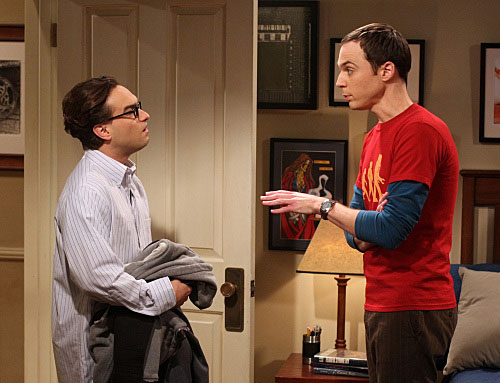 |
| Johnny Galecki (left) as Dr. Leonard Hofstadter; Jim Parsons (right) as Dr. Sheldon Cooper |
I contend they represent not two conflicting dweeb types, but outward expressions of conflicting desires shared by anyone who has ever cared deeply enough about anything to let it separate themselves from others. If audiences like Leonard because he embodies the part of us that yearns for freedom and normalcy, it follows that Sheldon embodies the part that would swear off distractions and vanish into whatever we most cherish. Neither character represents science exclusively; anyone who has ever loved doing anything—rebuilding car engines, Italian cooking, raising our families—has felt these same conflicting desires.
Thus, we like Sheldon for the same reason we enjoy characters like Dr. House: we envy his liberty to disdain what others think, because we know we never can. Though Jim Parsons plays Sheldon as plagued with excessive tics and tremors, his exaggerated manner only highlights the inner character. Everyone struggles between wanting to fit in and be liked, and wanting to do what really animates us. We know we’d dislike being at the receiving end of that arc. Nevertheless, who wouldn’t rather throw off the pressure to fit in, be attractive, and let others impose themselves on is, in favor of painting, acting, gardening, or whatever we love?
Leonard understands why Sheldon is awful, and even occasionally comments on it. Unlike Sheldon, Leonard seeks freedom to join other people, not ignore them: he wants the influences that bind others. But that traps him. He can never reject Sheldon because he needs Sheldon to like him, too. That scientific immersion is part of him, too, which he must embrace, because he can’t be liked by others if he can’t simultaneously like himself. Thus he continues to feed Sheldon’s superhero fantasies and play university politics when, at least sometimes, he’d rather abandon both and live free.
 What, then, is freedom? Leonard wants freedom to be liked by others. But when he achieves that, he finds it unsatisfying. In Season 3, Episode 6, “The Cornhusker Vortex,” Leonard tries to join his sweetheart Penny in watching football. But he finds it ultimately frustrating and flees to join his friends. Unfortunately, Leonard doesn’t just want others to like him, he wants others to like him as he is. He cannot stop being Leonard, but he wants to be liked as Leonard, which proves not only frustrating, but the opposite of liberating.
What, then, is freedom? Leonard wants freedom to be liked by others. But when he achieves that, he finds it unsatisfying. In Season 3, Episode 6, “The Cornhusker Vortex,” Leonard tries to join his sweetheart Penny in watching football. But he finds it ultimately frustrating and flees to join his friends. Unfortunately, Leonard doesn’t just want others to like him, he wants others to like him as he is. He cannot stop being Leonard, but he wants to be liked as Leonard, which proves not only frustrating, but the opposite of liberating.During his courtship of Penny, Leonard’s inability to compromise causes conflict. In Season 1, Episode 14, “The Nerdvana Annihilation,” the newest addition to Leonard’s science fiction memorabilia collection causes Penny to miss a day’s work, leading to confrontation. The question arises: are Leonard’s toys part of him, or an attempt to flee the larger world? Must he relinquish his simple joys in order to “put away childish things”? Though the episode offers pat resolution, further consideration reveals that Leonard became a physicist for the simple joy of discovering how the world works. His toys are part of that simple joyousness.
But in discovering how “the world” works, he’s isolated himself from daily living. Quarks and mesons seem straightforward compared to the complexity of daily living. Leonard can’t simultaneously observe the world and join it: he must make a choice. In that way, Sheldon is freer than Leonard, because without the impulse to join, he has the liberty to stand outside and watch. When the two halves of Leonard’s life come into inevitable conflict, Sheldon’s freedom from choosing must seem downright pleasurable.
Sheldon has freedom to disregard convention and follow whatever whims pull him. Just because others don’t like or approve means little to him, because he’s forgotten more than most people ever know. Indeed, others’ scorn gives him ammunition to delve further into himself. Reality is a tedious imposition.
Thus Sheldon represents a part of anybody, not just smart people. And Leonard exists because we need to resist. We need other people to feel complete in ourselves. We just—if we’re honest—would rather not.
Part Two: The Penny Polarization
Part Three: The Raj/Howard Continuum
No comments:
Post a Comment